Vulpes
Vulpes is a genus of the dog subfamily Caninae. The members of this genus are colloquially referred to as true foxes, meaning they form a proper clade. The word "fox" occurs on the common names of species. True foxes are distinguished from members of the genus Canis, such as domesticated dogs, wolves, jackals and coyotes, by their smaller size (5–11 kg) and flatter skull.[2] They have black, triangular markings between their eyes and nose, and the tip of their tail is often a different color from the rest of their pelt. The typical lifespan for this genus is between two and four years, but can reach up to a decade.[2]
| Vulpes | |
|---|---|
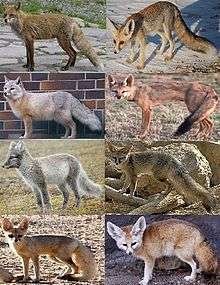 | |
| Various true foxes: left to right, then top to bottom: red fox, Rüppell's fox, corsac fox, Bengal fox, Arctic fox, Blanford's fox, Cape fox, and fennec fox | |
| Scientific classification | |
| Kingdom: | Animalia |
| Phylum: | Chordata |
| Class: | Mammalia |
| Order: | Carnivora |
| Family: | Canidae |
| Subfamily: | Caninae |
| Tribe: | Vulpini |
| Genus: | Vulpes Frisch, 1775 |
| Type species | |
| Vulpes vulpes[1] (Linnaeus, 1758) | |
| Species | |
For animals commonly known as "foxes", but which are not true foxes, see Fox#Classification.
Extant species
Within Vulpes, 12 separate and distinct extant species and four fossil species are described:
| Image | Scientific name | Common Name | Distribution | Distribution map |
|---|---|---|---|---|
.jpg) | V. lagopus | Arctic fox | Arctic foxes inhabit all of the Arctic (Russia, Svalbard, Iceland, parts of Scandinavia, Finland, Greenland, Northern Canada, and Alaska).[3] This fox is Iceland's only native land mammal.[4] It arrived there during the climax of the last ice age, when the seas were frozen enough to walk across. The Arctic fox is most closely related to the kit (V. macrotis) and swift (V. velox) foxes. |  |
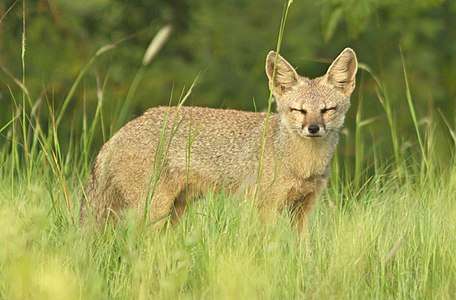 | V. bengalensis | Bengal fox | Bengal foxes are endemic to India and live throughout the subcontinent, and have not been placed on the endangered species list, but have become threatened by lack of native habitat due to human expansion.[5] | 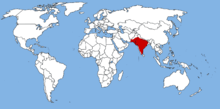 |
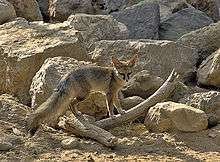 | V. cana | Blanford's fox | Blanford's fox dwells in section of the Middle East including Iran and Israel, as well as Afghanistan, Egypt, Turkestan, Iran, Pakistan, and Israel. This species prefers semiarid environments.[6] | .svg.png) |
.jpg) | V. chama | Cape fox | The Cape fox is only found in the south of Africa, including Zimbabwe, Botswana, and South Africa. They thrive in semiarid and arid environments with rich grasslands. | 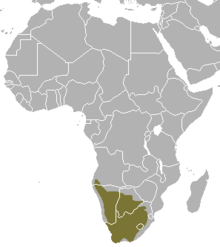 |
 | V. corsac | Corsac fox | Corsac foxes live in central Asia. Like V. chama and V. cana, they do best in semiarid deserts. This fox is within the holarctic clade of foxes. This clade also contains the Arctic fox, swift fox, and red fox. Their possible ancestor is V. praecorsac, meaning they may have had a much wider distribution in the past (Europe and Crimea).[7] | 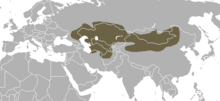 |
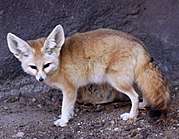 | V. zerda | Fennec fox | The fennec fox lives in the northernmost sections of Africa. It was not previously within Vulpes, but genetic evidence shows its close relation with Blanford's fox, making it a true fox.[8] | 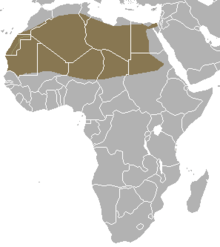 |
 | V. macrotis | Kit fox | Kit foxes are an arid area-dwelling North American species. They are found in Oregon, Colorado, Nevada, Utah, California, New Mexico, and Texas. They also have a population in Mexico. | 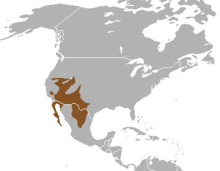 |
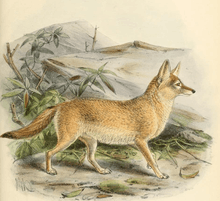 | V. pallida | Pale fox | The pale fox lives in upper middle Africa and is an arid area-dwelling species.[9] | 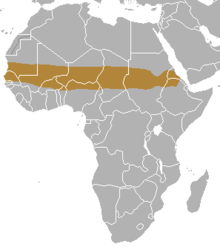 |
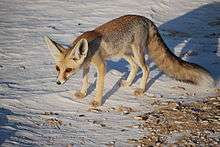 | V. rueppellii | Rüppell's fox | Ruppell's foxes are specific to northern Africa and sections of the Middle East.[10] | 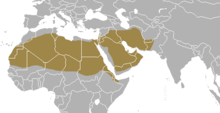 |
.jpg) | V. vulpes | Red fox, silver fox and cross fox | The red fox is the most abundant and most widely distributed species of Vulpes. They currently live in most sections of the Northern Hemisphere. They also are present in Australia, though they were brought there by humans for fox hunting in the 1830s and are considered an invasive species. This species’ ancestor (either V. alopecoides or the related Chinese V. chikushanensi) originated in the Early Pleistocene and they are most closely related to Ruppell's fox (V. rueppellii).[11] | 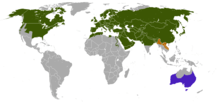 |
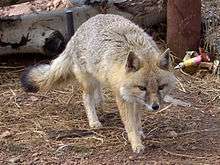 | V. velox | Swift fox | The swift fox is found in the western grasslands of North America, specifically Montana, Wyoming, New Mexico, Colorado, Kansas, Oklahoma, and Texas, as well as some sections of Canada. This species is most closely related to the kit fox, but lives in a different section of North America. The two can interbreed.[12] |  |
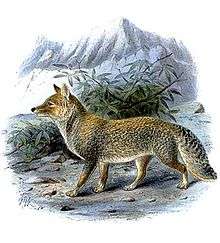 | V. ferrilata | Tibetan sand fox | The Tibetan sand fox, as the name suggests, is endemic to the Tibetan and Ladakh plateau in Nepal, China, Sikkim, and Bhutan. This species lives at altitudes up to 5300 m and semideserts.[13] | 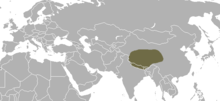 |
The Arctic fox is sometimes included in this genus as Vulpes lagopus based on the definitive mammal taxonomy list, as well as genetic evidence.[1][14]
Foxes of this group (including the fennec and Arctic foxes) possess eyes with pupils that retract into vertical slits in bright light.
The red fox, Ruppell's fox,[15] and Tibetan sand fox [16] possess white-tipped tails. The Arctic fox's tail-tip is of the same color as the rest of the tail (white or blue-gray)[17] Blanford's fox usually possesses a black-tipped tail, but a small number of specimens (2% in Israel, 24% in the United Arab Emirates) possess a light-tipped tail.[18] The other foxes in this group (Bengal, Cape, corsac, fennec, kit, pale, and swift) all possess black-tipped or dark-tipped tails.[19]
Fossil species
- †Vulpes hassani
- †Vulpes praeglacialis - Kormos (found in Petralona Cave, Greece)
- †Vulpes qiuzhudingi (2014)
- †Vulpes riffautae - Late Miocene
- †Vulpes skinneri
- †Vulpes stenognathus
Early history
The oldest known fossil species within Vulpes is V. riffautae, dating back to the late Miocene of Chad, which is within the Neogene. The deposits where these fossils are found are about 7 million years old, which might make them the earliest Canidae in the Old World. They are estimated to have weighed between 1.5 and 3.5 lb. V. skinneri, from the Malapa fossil site from South Africa, is younger than V. riffautae by roughly 5 million years, and shows up in the early Pleistocene.[20]
Two other extinct, less documented fossils are known: V. praeglacialis and V. hassani. V. praeglacialis was discovered in the Petralona Cave in Chalkidiki, Greece. The age of the deposits (Early Pleistocene) makes it the earliest occurrence of Vulpes in Europe. V. hassani is found in a Miocene-Pliocene deposit in northwestern Africa.[21]
In the Pleistocene, Vulpes had a fairly wide distribution, with eight species found in North America. Of these eight, six are not fossil, and three species still remain in North America (V. velox, V. macrotis, and V. vulpes). The remaining three moved on to sections of Africa over time. V. stenognathus is extinct, but has extant sister taxa including V. chama, V. rueppellii, V. velox, and V. vulpes, which fits with these species all evolving together in North America.[22]
Anatomy
Vulpes has a very similar bone structure to its canid relatives, but does have some modifications. Although canid limbs are designed specifically for running quickly on land to catch prey, Vulpes species avoid rapid sprints, excluding being chased, and have become more specialized for leaping and grasping prey.
The adaptions for leaping, grasping, and climbing include the lengthening of hind limbs in relation to fore limbs, as well as overall slenderizing of both hind and fore limbs. Muscles are also emphasized along the axis of limbs.
Diet
This genus is omnivorous and prone to scavenging. The foods of choice for Vulpes consist of invertebrates, a variety of small vertebrates, grasses, and some angiosperms. The typical intake per day is about 1 kg. True foxes exhibit hoarding behavior or caching where they store away food for another day out of sight from other animals.[23]
Habitat
These foxes can dwell in a number of habitats, including alpine, forest, desert, coastal, farm, and urban areas, but thrive in environments rich in food and shelter. They can be found in great numbers in suburban/residential regions. For the most part, this coexistence is agreeable for both fox and man, but can sometimes result in house pet (cat) disappearances.[24]
Behavior
General overview
Though this varies in intensity from species to species, foxes operate within a hierarchical society, where dominance is established early in life. Dominant kits receive more food and are subsequently larger. If a dispute in the hierarchy occurs, dominance is determined by fighting. The loser may be subjected to rejection from its social group, as well as serious injuries. These social groups usually consist of three or four adults and have not been documented to surpass 10 adults.[25] Vulpes species are usually nocturnal, but do occasionally hunt and scavenge in daylight during winter.
Reproduction
A male is referred to as a dog, and the female as a vixen. They are very similar in appearance, though dogs have larger heads. Mating occurs in late winter. This mating process starts when the vixen digs out an undisclosed number of potential breeding dens and begins to release a mating scent. Gestation takes 7–8 weeks, putting typical birth occurrence in March, and on average, kits begin to emerge in late April. The parents work as a unit in the upbringing of their offspring.[25]
After birth
Born deaf and blind, kits or cubs require their mother's milk and complete supervision for the first four to five weeks out of the womb, but begin to be progressively weaned after the first month. Once fully weaned, kits seek out various insects. The parents supplement this diet with a variety of mammals and birds. During early to middle July, the kits are able to hunt on their own and soon move away from their parents.[25]
Domestication
Though rare, domestication has been documented. The most notable case documented is the domestication of the red fox in Novosibirsk, Russia, at the Siberian Institute of Cytology and Genetics.[26] In this study, generations of silver foxes were divided into those with friendly traits and those with unfriendly traits.[27] After 50 years, the friendly foxes developed “dog-like” domesticated traits such as spots, tail wagging, enjoyment of human touch, and barking.[28]
Fox hunting
Fox hunting was started in the United Kingdom in the 16th century that involves tracking, chasing, and killing a fox with the aid of foxhounds and horses. It has since then spread to Europe, the United States, and Australia.[29]
Vulpes in culture and literature
External links
| Wikispecies has information related to Vulpes |
![]()
References
- Wozencraft, W.C. (2005). "Order Carnivora". In Wilson, D.E.; Reeder, D.M (eds.). Mammal Species of the World: A Taxonomic and Geographic Reference (3rd ed.). Johns Hopkins University Press. pp. 532–628. ISBN 978-0-8018-8221-0. OCLC 62265494.
- Macdonald, David (1984). The Encyclopedia of Mammals. New York: Fun Facts on File. P. 31. ISBN 0-87196-871-1
- "Basic Facts About Arctic Foxes". 19 March 2012.
- "Wildlife". Iceland Worldwide. iww.is. 2000. Archived from the original on 14 April 2010. Retrieved 22 April 2010.
- Vanak, A.T. (2005). "Distribution and status of the Indian fox Vulpes bengalensis in southern India".Canid News 8 (1).
- "Blanford's fox". Breeding Centre for Endangered Arabian Wildlife. 29 August 2007. Retrieved 31 August 2010.
- Zrzavý, J.; Řicánková, R. (1999). "Phylogeny of Recent Canidae (Mammalia, Carnivora): relative reliability and utility of morphological and molecular datasets". Zoologica Scripta. 33 (4): 311–333. doi:10.1111/j.0300-3256.2004.00152.x.
- Linblad-Th, K.; Wade, CM; Mikkelsen, TS; Karlsson, EK; Jaffe, DB; Kamal, M; Clamp, M; Chang, JL; et al. (2005). "Genome sequence, comparative analysis and haplotype structure of the domestic dog". Nature. 438 (7069): 803–819. doi:10.1038/nature04338. PMID 16341006.
- “Vulpes pallida” "Archived copy". Archived from the original on 2011-10-28. Retrieved 2011-10-24.CS1 maint: archived copy as title (link). Canid Specialist Group
- Wozencraft, W. C. (2005). "Order Carnivora". In Wilson, D. E.; Reeder, D. M. Mammal Species of the World (3rd ed.). Johns Hopkins University Press.
- Kurtén 1980, pp. 96, 174
- Dragoo, J. W., Choate, J. R., Yates, T. L., & O'Farrell, T. P. (1990). "Evolutionary and taxonomic relationships among North American arid-land foxes". Journal of Mammalogy (American Society of Mammalogists) 71 (3): 318–332. doi:10.2307/1381942. JSTOR 1381942
- Schaller, G.B., Ginsberg, J.R. & Harris, R. (2008). Vulpes ferrilata. In: IUCN 2008. IUCN Red List of Threatened Species. Retrieved 22 March 2009.
- Bininda-Emonds, ORP; JL Gittleman; A Purvis (1999). "Building large trees by combining phylogenetic information: a complete phylogeny of the extant Carnivora (Mammalia)" (PDF). Biol. Rev. 74 (2): 143–175. CiteSeerX 10.1.1.328.7194. doi:10.1017/S0006323199005307. PMID 10396181. Retrieved 2008-07-30.
- Sillero-Zubiri, Claudio; Hoffman, Michael; and MacDonald David W. Canids: Foxes, Wolves, Jackals, and Dogs: Status Survey and Conservation Action Plan. Gland, Switzerland and Cambridge, UK: IUCN; 2004. p213
- Sillero-Zubiri, Claudio; Hoffman, Michael; and MacDonald David W. Canids: Foxes, Wolves, Jackals, and Dogs: Status Survey and Conservation Action Plan. Gland, Switzerland and Cambridge, UK: IUCN; 2004. p161
- Burt, William Henry. A Field Guide to the Mammals of North America North of Mexico. Boston: Houghton Mifflin Harcourt; 1998. pp75 and Plate 7
- Sillero-Zubiri, Claudio; Hoffman, Michael; and MacDonald David W. Canids: Foxes, Wolves, Jackals, and Dogs: Status Survey and Conservation Action Plan. Gland, Switzerland and Cambridge, UK: IUCN; 2004. p206
- Sillero-Zubiri, Claudio; Hoffman, Michael; and MacDonald David W. Canids: Foxes, Wolves, Jackals, and Dogs: Status Survey and Conservation Action Plan. Gland, Switzerland and Cambridge, UK: IUCN; 2004.pp202,231,205,211,155,122,117
- De, Bonis; et al. (2007). "The oldest African fox (Vulpes riffautae n. sp., Canidae, Carnivora) recovered in late Miocene deposits of the Djurab desert, Chad". Naturwissenschaften. 94 (7): 575–580. doi:10.1007/s00114-007-0230-6. PMID 17361401.
- De, Bonis; et al. (2007). "The oldest African fox (Vulpes riffautae n. sp., Canidae, Carnivora) recovered in late Miocene deposits of the Djurab desert, Chad". Naturwissenschaften. 94 (7): 575–580. doi:10.1007/s00114-007-0230-6. PMID 17361401.
- D. E. Savage. 1941. American Midland Naturalist 25
- Fedriani, J.M.; T. K. Fuller, R. M. Sauvajot, E. C. York (2000-07-05). "Competition and intraguild predation amount three sympatric carnivores" Oecologia 125 (2) 258-270. doi:10.1007/s004420000448.
- "History and biology". Feral Scan/Fox Scan. http://www.feralscan.org.au/foxscan/pagecontent.aspx?page=fox_historyandbiology. Retrieved 2014-04-01.
- Harris, Steven (2010). "Understand fox behavior". https://www.discoverwildlife.com/animal-facts/mammals/understand-fox-behaviour/. Retrieved 2014-03-23.
- Trut, Lyudmila (1999). "Early Canid Domestication: The Farm-Fox Experiment". American Scientist. 87 (2): 160. doi:10.1511/1999.2.160.
- Kukekova, Anna V.; Trut, L. N.; Chase, K.; Shepeleva, D. V.; Vladimirova, A. V.; Kharlamova, A. V.; Oskina, I. N.; Stepika, A.; Klebanov, S.; Erb, H. N.; Acland, G. M. (2008-03-01). "Measurement of Segregating Behaviors in Experimental Silver Fox Pedigrees". Behavior Genetics. 38 (2): 185–194. doi:10.1007/s10519-007-9180-1. ISSN 1573-3297. PMC 2374754. PMID 18030612.
- Lord, Kathryn A.; Larson, Greger; Coppinger, Raymond P.; Karlsson, Elinor K. (2020-02-01). "The History of Farm Foxes Undermines the Animal Domestication Syndrome". Trends in Ecology & Evolution. 35 (2): 125–136. doi:10.1016/j.tree.2019.10.011. ISSN 0169-5347. PMID 31810775.
- "Fox hunting worldwide". BBC News. 1999-09-16. Retrieved 2014-03-29